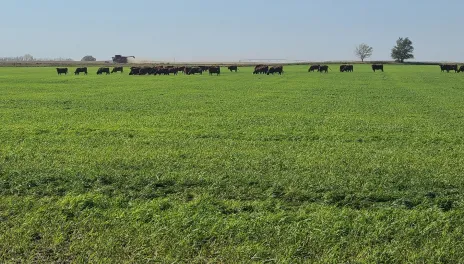To Graze or Not to Graze?
The last half of 2021 has provided a nice reprieve from recent difficult falls. If you were prepared, it was an excellent opportunity to get cover crops going. On the other hand, it was also a great chance to see what our early season volunteer cash crops can offer our cropping systems. In many cases our cool season crops produced a second crop that was nearly producing viable seed. There has been much recent emphasis on getting cover crop established in fields, including decisions about species/mixtures and planting dates, but one thing that hasn’t changed over the years is that a fall volunteer crop almost always appears. If we put more thought into how we want our volunteer crop to appear we could have a no-pass cover crop on a high percent of acres.
This fall gave us a great chance to observe different strategies for forage production on two different systems: pearl millet planted following rye grain crop harvest, and barley cover crop following small grain harvest. Pearl millet is a warm season crop while barley is cool season. Both forage crops got off to an excellent start. Based on proximity, we decided to graze the barley forage but hay the pearl millet. In retrospect, it would have been better to switch the two practices if at all possible. Here is what we learned:
The late July planting of the pearl millet was too late. Even with our extended frost-free fall, the millet was not able to produce as hoped. While the stand was very good, the plants had heavy competition from volunteer winter rye and were nitrogen stressed. The millet was cut the first week of October and we obtained roughly 1.25 bales per acre. Conversely when the cows were put out onto the barley, we estimated dry matter production to be about 600 lb/a. On that area (roughly 30 acres) we had 44 cows grazing for 25 days. This was wonderful production for an area that was not planned to be grazed.
We were not intending to compare these examples to each other and it should be noted that the millet would have served wonderfully as a grazing crop this fall. To answer the titled question, this fall was the time to graze. However, after three years of fall moisture problems and a disappointing summer rain it was easy to feel disheartened and miss out on this opportunity. When it comes to growing a second crop in North Dakota, the key is to always be prepared for what mother nature brings us.
Mike Ostlie, Ph. D.
Mike.Ostlie@ndsu.edu
Research Agronomist

